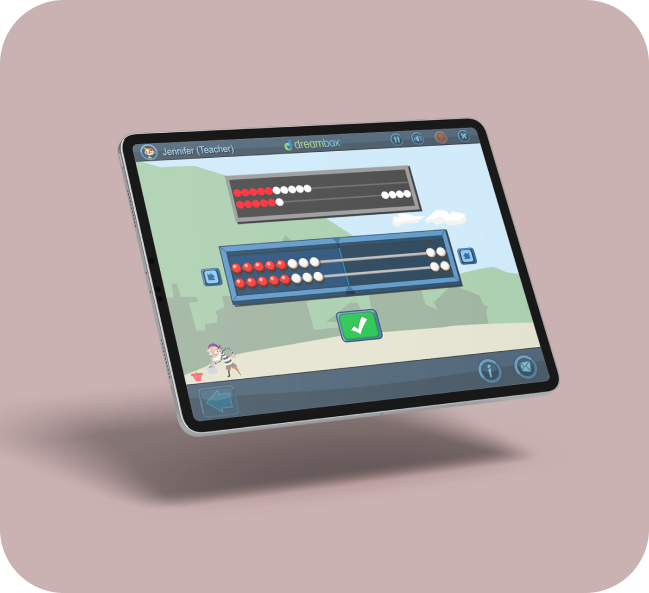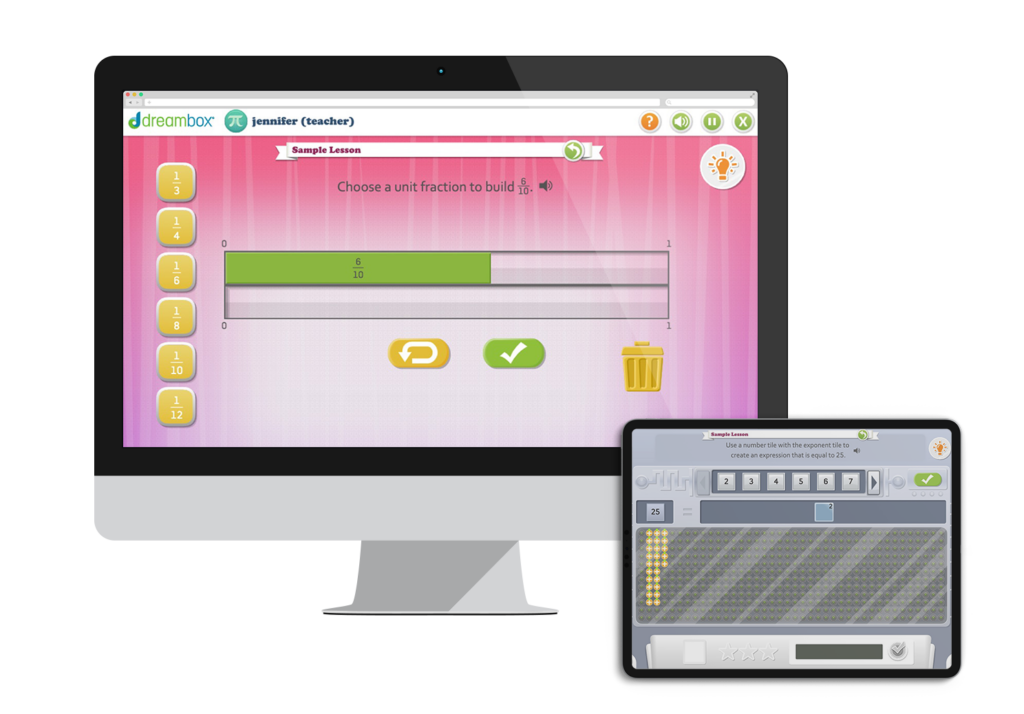If you’re looking for ways to help your child boost their math skills and confidence, don’t miss this list of 40 fourth grade math problems!

Boost fourth grade math
skills with DreamBox
Discover an interactive math program your fourth grader will love.
Whether your fourth grader needs some math support or wants to master new skills, our interactive program keeps them engaged in learning. DreamBox uses interactive games and a proven curriculum to enhance your fourth grader’s math skills—and their confidence.
Boost fourth grade math skills with DreamBox
Discover an interactive math program your fourth grader will love.
Whether your fourth grader needs some math support or wants to master new skills, our interactive program keeps them engaged in learning. DreamBox uses interactive games and a proven curriculum to enhance your fourth grader’s math skills—and their confidence.

Tailored learning for every fourth grader
REAL-TIME ADAPTIVE LESSONS
Each fourth grader has a unique learning style, and DreamBox adapts instantly to meet their specific needs. Whether they’re excelling or need extra help, DreamBox personalizes lessons to foster growth and confidence.
Effortless setup
START FOR FREE
Getting started with DreamBox is simple and stress-free! Enjoy a free 14-day trial—no credit card required—and discover a program built to help your fourth grader thrive in math.


Targeted learning
DEVELOP SPECIFIC SKILLS
If your fourth grader excels in geometry but needs help with division, DreamBox’s assignment tool monitors progress and targets areas for improvement. Customize their learning plan to build confidence and enhance critical skills.
Start your free trial
See how DreamBox can help your fourth grader with math by signing up for a free trial today.
No credit card required!
Parents and teachers love DreamBox
“It’s the only computer-based tool that I know of that really takes a learner beyond the average.”
Lynda J.
Instructional Design Coach
“If we struggle with fourth-grade fractions, we struggle with fifth-grade fractions, it just compounds. DreamBox really allows us to hone in on where we need to put in extra work.”
Stacy M.
Assistant Principal
“So, the teachers actually really like [DreamBox] because they don’t
necessarily have to reteach and lose class time of math. They can use DreamBox to supplement the skills that [students] need.”
necessarily have to reteach and lose class time of math. They can use DreamBox to supplement the skills that [students] need.”
Craig V.
Data Specialist
“It’s the only computer-based tool that I know of that really takes a learner beyond the average.”
Lynda J.
Instructional Design Coach
“If we struggle with fourth-grade fractions, we struggle with fifth-grade fractions, it just compounds. DreamBox really allows us to hone in on where we need to put in extra work.”
Stacy M.
Assistant Principal
Benefits of DreamBox for fourth grade math
According to the latest study, only 36% of fourth graders performed at or above the standard math proficiency level (NAEP Report Card). DreamBox can help students get back on track—and have fun doing it. DreamBox Math stands apart by making math enjoyable for fourth graders while providing parents and educators with meaningful progress insights.
Personalized Lesson Plans
DreamBox tailors content to your fourth grader’s current skills as they complete lessons, creating an optimized learning experience.
Measurable Progress
DreamBox delivers real results. Children spending just 30–60 minutes weekly on DreamBox typically achieve 1.5 grade levels of improvement by year’s end.
Proven Success
DreamBox Learning is the only dual-discipline program rated STRONG by Evidence for ESSA, demonstrating efficacy across all achievement levels and learning environments.
Designed for Fourth Graders
DreamBox Math captivates students with interactive games, delightful characters, and stimulating challenges.
Ongoing Progress Tracking
DreamBox continuously tracks progress, removing the need for single-placement tests. Get a clear understanding of their achievements, growth, and performance trends.
Valuable Screen Time
Engaging lessons turn screen time into a positive and productive way for your fourth grader to learn and grow.
Personalized Lesson Plans
DreamBox tailors content to your fourth grader’s current skills as they complete lessons, creating an optimized learning experience.
Measurable Progress
DreamBox delivers real results. Children spending just 30–60 minutes weekly on DreamBox typically achieve 1.5 grade levels of improvement by year’s end.
Proven Success
DreamBox Learning is the only dual-discipline program rated STRONG by Evidence for ESSA, demonstrating efficacy across all achievement levels and learning environments.
Designed for Fourth Graders
DreamBox Math captivates students with interactive games, delightful characters, and stimulating challenges.
Ongoing Progress Tracking
DreamBox continuously tracks progress, removing the need for single-placement tests. Get a clear understanding of their achievements, growth, and performance trends.
Valuable Screen Time
Engaging lessons turn screen time into a positive and productive way for your fourth grader to learn and grow.
Designed for fourth graders
DreamBox Math captivates students with interactive games, delightful characters, and stimulating challenges.
Ongoing progress tracking
DreamBox continuously tracks progress, removing the need for single-placement tests. Get a clear understanding of their achievements, growth, and performance trends.
Valuable screen time
Engaging lessons turn screen time into a positive and productive way for your fourth grader to learn and grow.
Personalized lesson plans
DreamBox tailors content to your fourth grader’s current skills as they complete lessons, creating an optimized learning experience.
Measurable progress
DreamBox delivers real results. Children spending just 30–60 minutes weekly on DreamBox typically achieve 1.5 grade levels of improvement by year’s end.
Proven success
DreamBox Learning is the only dual-discipline program rated STRONG by Evidence for ESSA, demonstrating efficacy across all achievement levels and learning environments.
Fourth grade curriculum alignment
Our fourth grade online math practice tool and resources are aligned with educational math standards. By the end of the school year, your fourth grader should feel confident with these key math concepts:
- Addition and Subtraction:
- Addition Algorithm
- Subtraction Algorithm
- Whole Number Addition Strategies
- Whole Number Subtraction Strategies
- Adding or Subtracting 3 to 9
- Decomposing Fractions
- Comparison and Ordering:
- Comparing Fractions 1
- Comparing Fractions 2
- Geometry:
- Angle Measurement & Rotation
- Constructing & Measuring Polygons II
- Classifying Geometric Figures in a Hierarchy
- Classifying Polygons in a Hierarchy
- Drawing Lines of Symmetry
- Place Value:
- Decimals to the Thousandths Place
- Multiplication and Division:
- Composing Arrays to 600
- Division to 600
- Multiplication: Mixed Strategies
- Multiplication to 1,500
- Multiplication with Arrays & Landmarks I
- Multiplication with Arrays & Landmarks II
- Multiplication with Open Arrays
- Identifying Common Multiples
- Identifying Factors
- Patterning in Function Tables
- Fractions in the Real World 1
- Fractions in the Real World 2
- Fraction Multiplication
- Measurement:
- Elapsed Time
- Line Plots II
- Area & Perimeter II
Easy access anytime, anywhere
DreamBox is available on computers, laptops, and iPads through an internet browser and via our iPad app. Whether at home, in the car, or at the park, your first grader can keep practicing math wherever they are. At this time, DreamBox Math is not available on smartphones, Android tablets, or eReaders.

FAQs
Yes! DreamBox offers multiple grade levels and family plan options, making supporting your child’s math learning easier than ever.
DreamBox Math empowers fourth graders by analyzing how they solve problems. It adjusts activities to match their individual needs, ensuring they’re consistently challenged. DreamBox monitors progress as your child learns and grows and refines lessons to support their development. This personalized approach creates a unique learning journey tailored just for them!
Support your fourth grader by setting learning goals together! Kids love seeing their progress on DreamBox, which keeps them engaged and motivated. Start with small milestones based on lessons and then advance to focusing on mastering certain skills.
Celebrating their efforts and achievements builds their confidence. If they get frustrated, encourage persistence and discuss their learning. Simple questions like “What did you learn in math today?” can spark meaningful discussions and show your encouragement.
Track their progress with the DreamBox Family Dashboard and celebrate their achievements. You can even print certificates to commemorate milestones and celebrate their success!
No, there’s no credit card required to start a free trial with DreamBox.
Fourth grade math resources
Fourth-grade math helps students build the necessary foundation for more advanced mathematical reasoning. DoodleMath has the games, guides, and review tools your student needs to not only succeed but excel in their math class. Engage in regular practice to build confidence, tackle challenges – and see math for the adventure it is!
If you’ve ever wondered: How can I successfully help my fourth grader with math? This article is for you!
In 4th grade, students continue to develop their mathematical skills. Make practice time fun with these 4th-grade math activities!
Fourth grade math skills to practice
Multiplication can be fun with DreamBox! Discover some of the best multiplication tips and tricks to help your child become a confident problem solver.
Division can be one of the hardest math skills to master, but it’s super important in helping your child advance to higher-level mathematics.
Division won’t always give you a neat and clean answer – sometimes, you’ll be left with a remainder. Let’s explore what a remainder is and how to find it.
Converting units of measurement is an essential part of working with world measurement systems. Let’s learn the basics of unit conversions!
Learning how to measure angles is one of the most important skills to learn for geometry and higher-level math classes. We’re here to walk you through it!
The concept of area in math is about more than numbers and shapes; it’s about real-life applications.
Learn what perpendicular lines are, what they look like, their properties and how to draw them using different tools.
Factors are a nice first step in seeing the many ways different math rules and concepts overlap. We’ll look at how to factor and try some practice questions.
Prime factorization is one of the most fundamental ideas in math, and we use it in our everyday lives without realizing it!
Every child is going to encounter word problems in maths. Here are eight steps to solving word problems from a math tutor!
Master the math jargon with our A–Z of common math terms (and some handy ways to practice them!).
If homework is a source of frustration in your home, it doesn’t have to be that way! Read on to learn effective strategies to reduce homework stress.
Find other grades
If you’ve ever wondered how to help your child with math homework or what they should know by the end of fifth grade, these elementary math resources are for you.
Choose a grade level below to browse math skills and objectives by grade.
It’s time to build on what we’ve learnt so far and develop mathematical fluency.
Level up number knowledge with the introduction of multiplication, division and fractions.
Classifying, analysing and problem-solving: we’re applying all our skills here!
Understanding is extended even further across number, measurement and geometry.
Meet ratio, rational numbers and equations – this is where we explore statistical thinking.
Children learn more advanced topics like pre-algebra and investigate complex statistics and probability.
Introduce problems involving shape, scale drawings, population samples and more.




